Introduction:
The 4th century was a time of profound transformation and upheaval, leaving an indelible mark on the course of history. This era witnessed a convergence of pivotal and unique events that altered the political, religious, and cultural landscapes of the world. From Emperor Constantine’s conversion to Christianity, symbolized by his vision of the Chi-Rho, to the monumental First Council of Nicaea and the division of the Roman Empire into East and West, this century was characterized by a series of epoch-making occurrences. Additionally, it saw the rise of the Gupta Empire in India, the reign of Julian the Apostate, and the spread of Buddhism to Southeast Asia, among other significant developments. These events collectively laid the foundations for the evolving narratives of the future, making the 4th century a pivotal chapter in the annals of human history.
Emperor Constantine’s Conversion to Christianity: A Pivotal Turning Point in History

- Vision of the Chi-Rho Symbol: In the year 312 AD, Emperor Constantine experienced a vision of a radiant Chi-Rho symbol (☧) in the sky, along with the words “in hoc signo vinces” (in this sign, you will conquer). This vision is often cited as a significant moment in his journey toward Christianity and his subsequent decision to embrace the faith.
- Battle of the Milvian Bridge: The Chi-Rho vision is closely linked to the Battle of the Milvian Bridge, fought between Constantine and Maxentius for control of the Western Roman Empire. Constantine ordered the Chi-Rho symbol to be painted on his soldiers’ shields and banners. He emerged victorious in the battle, which he attributed to the divine intervention he believed he had received.
- Edict of Milan (313 AD): Following his victory at the Milvian Bridge, Constantine and his co-emperor Licinius issued the Edict of Milan, which granted religious tolerance to all, effectively ending the persecution of Christians. This edict was a pivotal step toward the eventual legalization of Christianity in the Roman Empire.
- Conversion and Baptism: While Constantine’s conversion to Christianity was gradual, he publicly declared his faith and was baptized shortly before his death in 337 AD. His conversion remains a topic of historical debate, as the details of his personal beliefs and the extent of his commitment to Christianity are not entirely clear.
- Council of Nicaea (325 AD): Constantine played a central role in convening the First Council of Nicaea in 325 AD. This ecumenical council addressed theological disputes within the early Christian church and laid the foundation for the Nicene Creed, a pivotal statement of Christian doctrine.
- Legacy: Constantine’s conversion to Christianity and his subsequent influence on the faith significantly altered the course of history. He played a pivotal role in the Christianization of the Roman Empire, leading to its eventual transformation into a Christian state under his successors. This era marked a turning point in the history of Christianity, as it shifted from being a persecuted minority religion to a major force within the Roman world.
Emperor Constantine’s conversion to Christianity, spurred by a vision, a military victory, and a deepening commitment to the faith, remains a compelling and transformative chapter in the history of both the Roman Empire and the Christian religion.
“Council of Nicaea (325 AD) and the Formulation of the Nicene Creed: Shaping Christian Doctrine”


- Emperor Constantine’s Role: The Council of Nicaea was convened by Emperor Constantine, marking a historic collaboration between church and state. This event exemplified the growing influence of Christianity within the Roman Empire.
- The Arian Controversy: The primary purpose of the council was to address the Arian controversy, a theological dispute centered on the nature of Christ. Arius, a priest, and theologian, believed that Jesus was a created being, whereas Orthodox Christians argued for Jesus’ equality with God the Father.
- The Nicene Creed: The council’s most enduring legacy is the Nicene Creed, a statement of Christian faith that defines the relationship between God the Father and Jesus Christ. It articulates the belief in the Holy Trinity and the divinity of Christ. The original Nicene Creed, with modifications, remains a core declaration of faith for most Christian denominations today.
- Debate and Resolution: The Nicene Creed was not unanimously accepted at the council. The debates were intense, with some bishops advocating for the Arian perspective. Ultimately, the Orthodox view prevailed, and the Nicene Creed was formulated to express the church’s theological stance.
- A Pivotal Moment: The Council of Nicaea was a critical moment in the development of Christian theology. It not only affirmed the divinity of Christ but also set the stage for subsequent ecumenical councils that further refined Christian doctrine.
- Role in the Eastern Orthodox Church: The Nicene Creed holds special significance in the Eastern Orthodox Church. It is recited in the Divine Liturgy and is central to Orthodox worship.
- Modern Influence: The Nicene Creed continues to be recited in Christian liturgies worldwide. It has played a unifying role in defining essential elements of Christian faith, transcending denominational differences.
- Ecclesiastical Canons: The Council of Nicaea also established various ecclesiastical canons, or church laws, addressing matters such as the calculation of the date of Easter, the authority of bishops, and the treatment of lapsed Christians during periods of persecution.
The Council of Nicaea in 325 AD was a pivotal event in the history of Christianity. It sought to resolve theological disputes, especially the Arian controversy, and produced the Nicene Creed, a statement of faith that remains a cornerstone of Christian doctrine and worship to this day. The council marked a defining moment in the relationship between the Roman Empire and the Christian Church, setting the stage for the development of core Christian beliefs and practices.
“Theodosius I: Shaping History Through Adoption of Christianity as the State Religion (380 AD)”
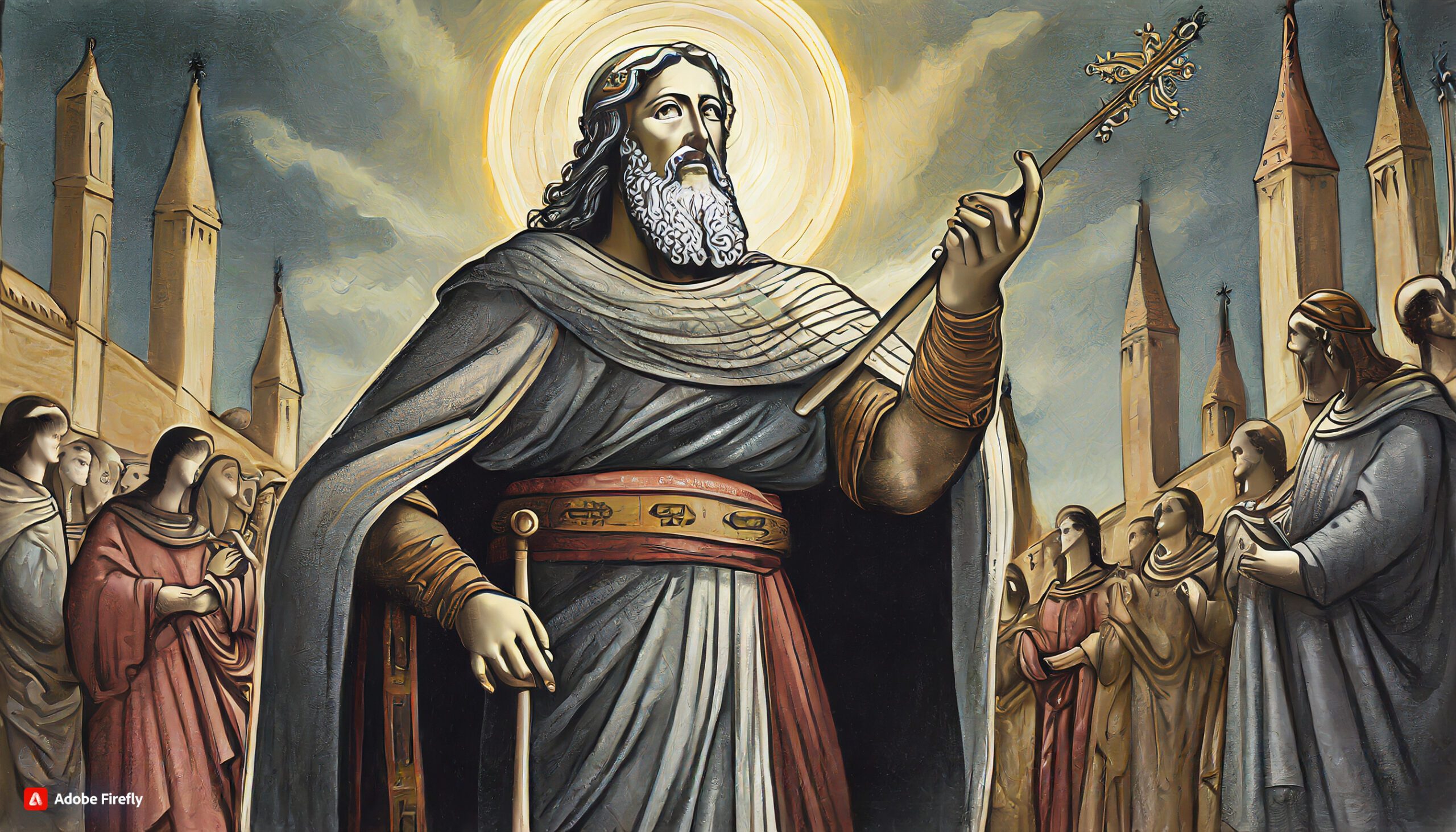

- Theodosius the Great: Theodosius I, often referred to as Theodosius the Great, was a Roman Emperor known for his pivotal role in the history of Christianity and the Roman Empire. His reign from 379 to 395 AD marked a turning point in the relationship between the state and the Christian Church.
- Edict of Thessalonica: In 380 AD, Theodosius issued the “Edict of Thessalonica,” also known as the “Cunctos populos” decree. This edict declared Christianity, specifically Nicene Christianity, as the state religion of the Roman Empire. It emphasized the Trinity and sought to suppress other religious practices, marking a significant shift in imperial policy.
- Unification of Faith: The Edict of Thessalonica aimed to promote religious unity within the empire by endorsing the Nicene Creed. It marked the end of religious toleration in the Roman Empire and initiated a period of Christian dominance in state affairs.
- Role in Early Christian Doctrine: Theodosius played a key role in several ecumenical councils that helped shape early Christian doctrine. His influence contributed to the development of the Nicene Creed and the establishment of key theological principles.
- Persecution of Paganism: As part of Theodosius’s efforts to promote Nicene Christianity, he enacted measures against pagan practices and temples, ultimately leading to the decline of traditional Roman paganism.
- Impact on Future Christian History: Theodosius’s actions had a profound influence on the history of Christianity. His endorsement of Nicene Christianity contributed to its widespread acceptance and set the stage for the establishment of Christianity as a dominant and enduring religious force in Europe.
- Continuing Influence: The legacy of Theodosius’s religious policies extended far beyond his reign. His establishment of Christianity as the state religion played a role in shaping the relationship between church and state in subsequent European history, leaving a lasting imprint on the development of Christian institutions.
Theodosius I’s adoption of Christianity as the state religion in 380 AD was a momentous event in the history of both the Roman Empire and Christianity. His reign set a precedent for the close ties between church and state, significantly impacting the development of Christian doctrine, the suppression of other religious practices, and the enduring influence of Christianity on Western civilization.
“The Roman Basilica of Maxentius and Constantine: An Architectural Marvel of 4th Century Rome (312-313 AD)”
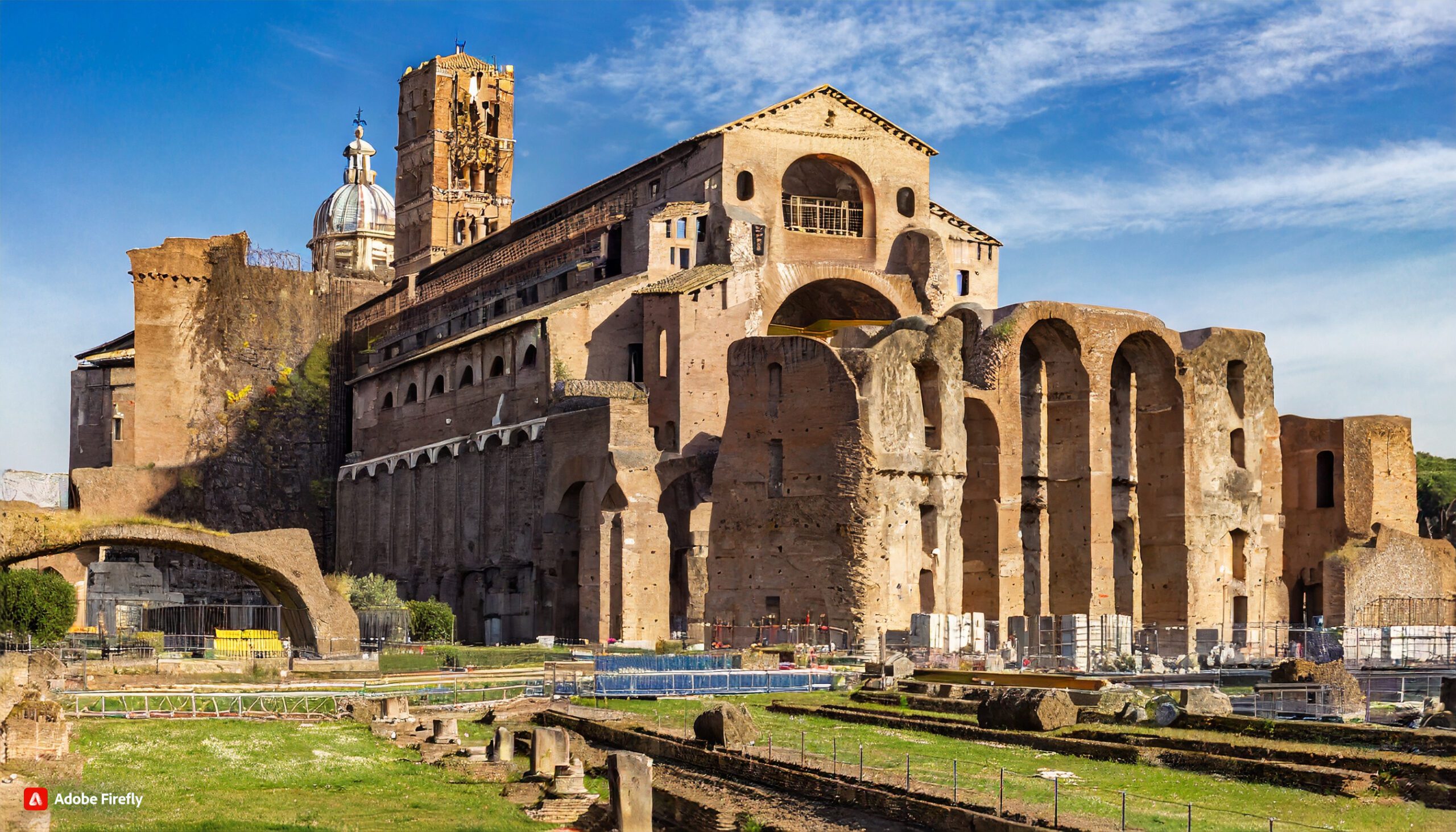

- Architectural Grandeur: The Basilica of Maxentius and Constantine, also known as the Basilica Nova, was a monumental civic building located in the Roman Forum. It is considered one of the most remarkable architectural achievements of ancient Rome, renowned for its immense size and grand design.
- Construction Date: The construction of the basilica took place during the reign of the Roman Emperors Maxentius (306-312 AD) and Constantine the Great (306-337 AD). It was primarily commissioned by Maxentius but completed by Constantine after his victory at the Battle of the Milvian Bridge in 312 AD.
- Imposing Dimensions: The basilica measured approximately 100 meters in length, 65 meters in width, and stood around 35 meters tall, making it one of the largest buildings of its time. It featured a central nave flanked by side aisles and a grand entrance hall.
- Innovative Architectural Features: The basilica was renowned for its innovative architectural elements, including a massive central nave with a soaring barrel-vaulted ceiling. It was adorned with a rich display of marble, ornate columns, and intricate carvings.
- Historical Significance: The Basilica of Maxentius and Constantine was historically significant for several reasons. It served as a venue for legal proceedings, commercial activities, and civic functions, setting the precedent for the future use of basilicas as law courts and meeting places.
- Surviving Fragments: Although the basilica was partially destroyed over the centuries, significant fragments of the structure, including parts of the colossal arches and the nave, have endured and are still visible today. These remnants offer a glimpse into the former splendor of this architectural marvel.
- Influence on Later Architecture: The innovative architectural features of the basilica, such as the use of concrete, monumental scale, and vaulted ceilings, had a profound influence on subsequent Roman and Byzantine architecture, as well as on the development of Christian basilicas and medieval cathedrals.
- Connection to Christian History: The Roman Basilica of Maxentius and Constantine played a role in early Christian history as it served as a backdrop to the victory of Constantine at the Battle of the Milvian Bridge in 312 AD. This battle is associated with Constantine’s vision of the Chi-Rho symbol and his subsequent conversion to Christianity.
The Basilica of Maxentius and Constantine stands as a testament to the architectural and engineering prowess of the Roman Empire. Its grandeur, size, and innovative design elements have left a lasting legacy on the development of civic and religious architecture and continue to captivate historians, archaeologists, and visitors to this day.
“The Great Fire of Rome (64 AD): Unraveling the Catastrophic Blaze in Ancient History”
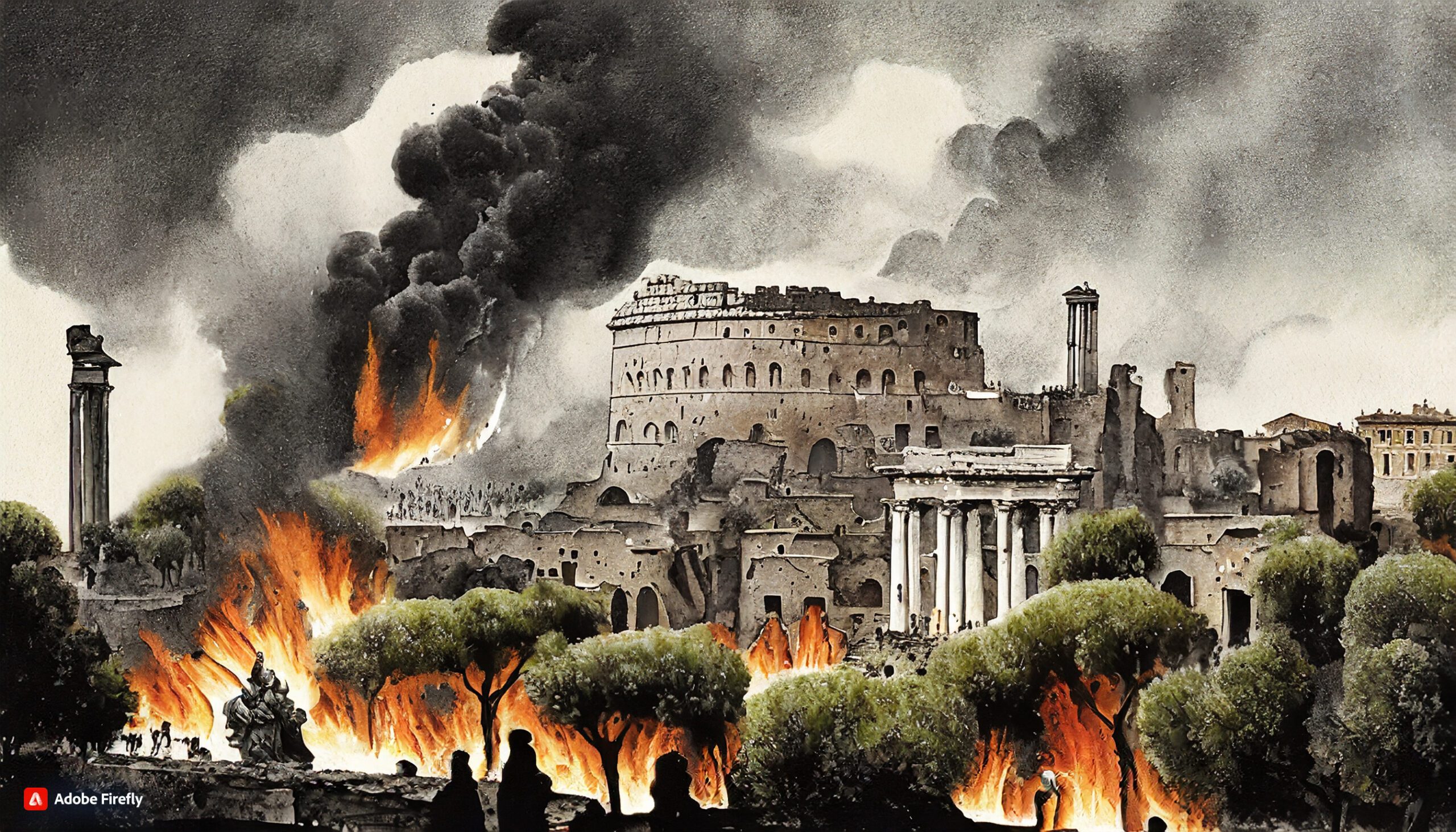

- Origin of the Fire: The Great Fire of Rome, which occurred in July of 64 AD, is believed to have started in the southeastern part of the city, near the Circus Maximus. The exact cause remains uncertain, but ancient sources suggest it may have been due to a combination of factors, including dry weather, strong winds, and flammable buildings.
- Extent of Destruction: The fire raged for approximately six days, devastating large portions of Rome. It consumed numerous residential areas, public buildings, and temples, leaving behind widespread destruction.
- Nero’s Role: Emperor Nero, who was in Antium at the time of the fire, returned to Rome and initiated relief efforts for the victims. However, some sources suggest that Nero was also rumored to have played the fiddle or lyre during the fire, a portrayal that has contributed to his historical image.
- Relief and Aid: In the aftermath of the fire, Nero organized relief for the survivors, providing food, shelter, and medical assistance to those affected. He also undertook urban planning reforms to rebuild the city.
- Construction Reforms: Nero’s efforts included new building codes aimed at reducing the risk of future fires. These regulations included wider streets, increased open spaces, and the use of fire-resistant building materials such as brick and stone.
- Blame and Persecution of Christians: Tacitus, the Roman historian, mentioned that Nero sought to shift blame for the fire onto the Christians, leading to the persecution of early Christians in Rome. This event marked one of the earliest instances of Christian persecution in the Roman Empire.
- Historical Accounts: Accounts of the Great Fire of Rome primarily come from Roman historians such as Tacitus and Suetonius. Their writings offer valuable insights into both the event itself and the political and social context of ancient Rome.
- Impact on Roman History: The Great Fire of Rome had a profound impact on the city’s urban planning and architectural development. It also contributed to the persecution of Christians and played a role in the complex legacy of Nero’s rule.
The Great Fire of Rome in 64 AD remains a pivotal event in Roman history, impacting not only the city’s physical landscape but also its cultural and social dynamics. The fire’s legacy, from its causes to its consequences, continues to intrigue historians and scholars, shedding light on the challenges and responses of ancient Rome in the face of calamity.
The Collapse of the Gupta Empire in India (c. 550 AD): A Turning Point in Indian History”
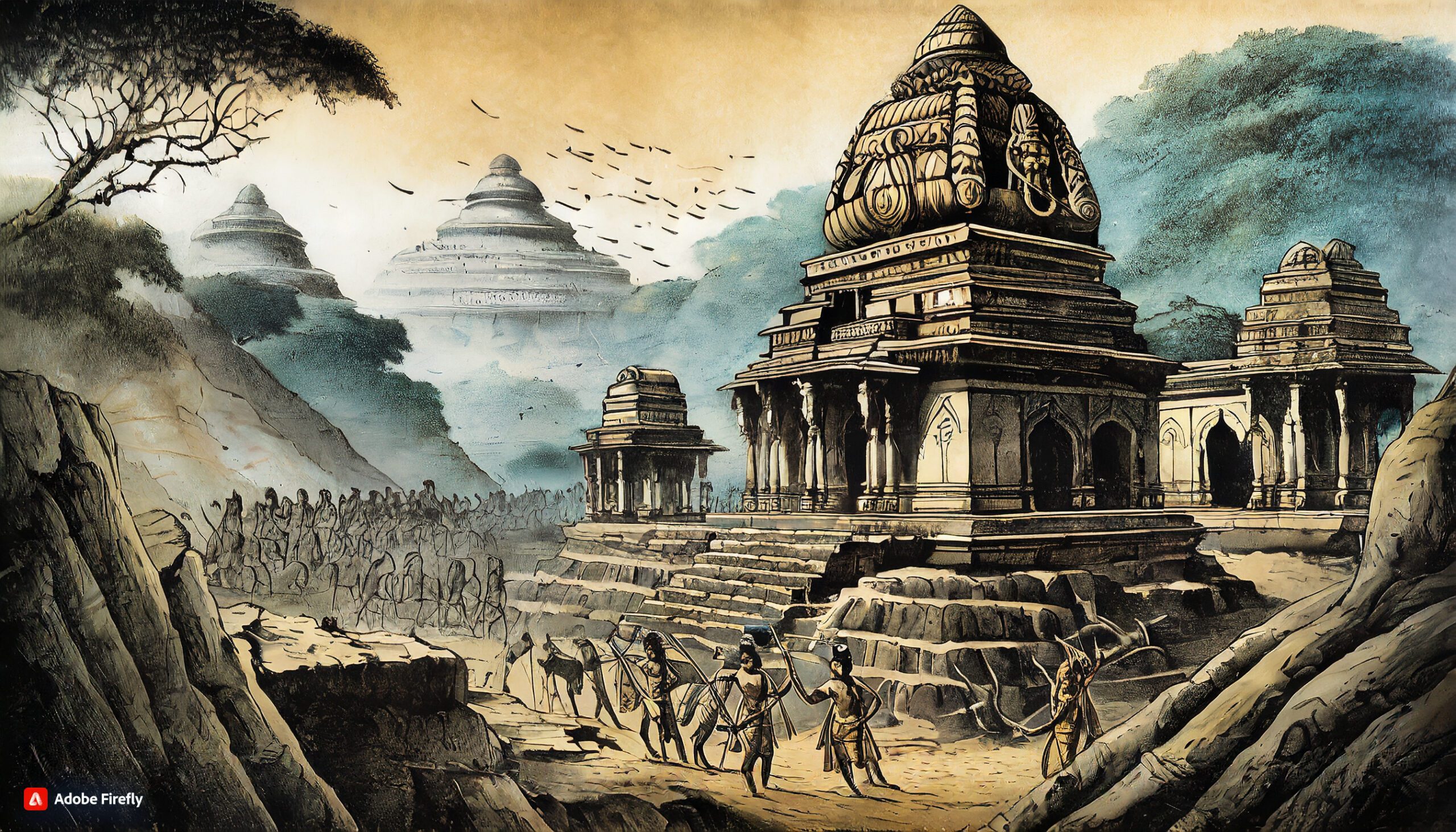

- Golden Age of India: The Gupta Empire is often referred to as the “Golden Age of India” due to its remarkable achievements in various fields, including art, science, mathematics, and literature. It is known for its patronage of scholars like Aryabhata and Kalidasa.
- Invasion of the White Huns: The Gupta Empire faced external threats from the White Huns, also known as the Hephthalites or Hunas. These Central Asian nomadic invaders played a significant role in the empire’s decline. Their incursions and conquests weakened Gupta authority.
- Era of Decentralization: The Gupta Empire started to weaken in the 6th century due to a series of internal and external challenges. The empire’s central authority diminished, and regional rulers gained more autonomy, effectively leading to a process of decentralization.
- Economic Factors: Economic factors also played a role in the empire’s decline. Factors such as currency devaluation and increased taxation, likely to support military efforts, led to economic strain and hardships for the populace.
- Role of Religion: The Gupta Empire had been known for its religious tolerance, but the White Huns, who followed different religious traditions, may have contributed to religious tensions within the empire.
- Contributions to Knowledge: Despite the empire’s decline, the Gupta period left an enduring legacy in the fields of mathematics, astronomy, and literature. The concept of zero, the decimal system, and the works of scholars like Aryabhata continued to influence Indian knowledge systems.
- End of an Era: The collapse of the Gupta Empire marked the end of a period of great cultural and intellectual flourishing in India. After the Gupta Empire’s decline, India saw a fragmentation of political power, paving the way for regional kingdoms and dynasties.
- Cultural Continuity: Even as the Gupta Empire declined politically, many of its cultural achievements continued to influence subsequent Indian civilizations, including the growth of Indian classical art and literature.
The collapse of the Gupta Empire in India around 550 AD represents a significant turning point in Indian history. It marked the end of a splendid era characterized by remarkable intellectual and cultural accomplishments and the beginning of a period of regionalization and the eventual emergence of new kingdoms and dynasties across the Indian subcontinent.
“The Spread of Buddhism to Southeast Asia: A Transcultural Journey”


- Early Beginnings: The spread of Buddhism to Southeast Asia began as early as the 3rd century BCE, shortly after the death of Siddhartha Gautama (Buddha). The Mauryan Emperor Ashoka played a pivotal role in sending Buddhist emissaries to various parts of Asia, including Southeast Asia, to propagate the teachings of Buddhism.
- Trade and Cultural Exchange: The expansion of Buddhism to Southeast Asia was closely tied to trade routes. Traders, merchants, and missionaries traveling along the Silk Road and maritime trade routes played a significant role in the dissemination of Buddhist ideas and practices to the region.
- Early Strongholds: The earliest known evidence of Buddhist influence in Southeast Asia can be found in inscriptions and archaeological remains in regions that are now part of modern-day Myanmar and Thailand. These areas became early strongholds of Buddhism in Southeast Asia.
- Theravada Buddhism: The form of Buddhism that predominantly spread throughout Southeast Asia is Theravada Buddhism. This tradition emphasizes the study of Buddhist scriptures and the pursuit of individual enlightenment through meditation.
- Monastic Communities: The establishment of monastic communities, known as sanghas, was a crucial aspect of the spread of Buddhism in Southeast Asia. These monastic centers served as centers of learning and helped propagate Buddhist teachings.
- Art and Architecture: The spread of Buddhism influenced the art and architecture of Southeast Asia. Iconic Buddhist monuments, such as stūpas, pagodas, and temples, were constructed throughout the region. Notable examples include the Borobudur in Indonesia and the Angkor Wat temple complex in Cambodia.
- Integration with Local Beliefs: Buddhism often integrated with pre-existing belief systems and local cultures in Southeast Asia. As it spread, it adapted to local customs and traditions, leading to the emergence of syncretic forms of Buddhism.
- Influence on Governance: Buddhist principles influenced the political and social structures of many Southeast Asian kingdoms. Monarchs often sought to align themselves with the Buddhist sangha, and legal codes were sometimes influenced by Buddhist ethics.
- Contemporary Significance: Today, Buddhism continues to be a significant and enduring aspect of the cultural and spiritual landscape of Southeast Asia. It plays a central role in the lives of millions of people in countries such as Thailand, Myanmar, Cambodia, Laos, and Sri Lanka.
The spread of Buddhism to Southeast Asia represents a fascinating chapter in the history of both the religion and the region. It underscores the interconnectedness of cultures, the importance of trade routes, and the adaptability of belief systems as they journey across borders and become integral to the identity of a region.
“The Dawn of Viking Raids: First Recorded Viking Raids in History”


- Monastery of Lindisfarne: The first recorded Viking raids are famously associated with the attack on the Christian monastery of Lindisfarne in 793 AD. This attack on the Holy Island marked a significant turning point in the history of Viking expansion.
- Sudden and Unexpected: The raid on Lindisfarne took the inhabitants by surprise. The peaceful monks and residents of the monastery were ill-prepared for the sudden and brutal assault by the Viking raiders.
- Treasure and Slaves: The primary motivations behind these early Viking raids were the acquisition of valuable loot, including precious metals, religious relics, and other treasures, as well as the capture of slaves. These raids were, in part, driven by economic incentives.
- Symbol of Viking Age Beginnings: The raid on Lindisfarne is often considered the symbolic beginning of the Viking Age, an era characterized by Viking expansion, exploration, and settlements in various parts of Europe, Asia, and even North America.
- Longships: Viking raiders were known for their longships, shallow-draft vessels that allowed them to navigate both open seas and rivers. These innovative ships gave the Vikings a distinct advantage in their raids and explorations.
- Range and Impact: Over the subsequent centuries, Viking raids extended far beyond Lindisfarne, with the Vikings reaching as far as the British Isles, Ireland, France, Spain, the Mediterranean, and the coast of North America. They established settlements, trade networks, and sometimes engaged in conflicts with local populations.
- Cultural Exchange: The Viking Age was not solely characterized by raiding; it also involved cultural exchanges. Vikings interacted with various cultures, adopting and adapting elements of foreign traditions and spreading their own, such as Norse mythology and the runic script.
- Legacy: The Viking Age left a lasting legacy in the form of language, place names, and DNA. Many areas the Vikings settled, such as the British Isles, still bear their influence today.
The first recorded Viking raids were the initial steps in a larger historical narrative that saw the Vikings emerge as significant players on the European and global stage. These raids set the stage for a complex and multifaceted period of Viking exploration, trade, conquest, and cultural exchange.
“The Huns Invade the Western Roman Empire (c. 375 AD): Unleashing the Storm of Barbarian Incursions”
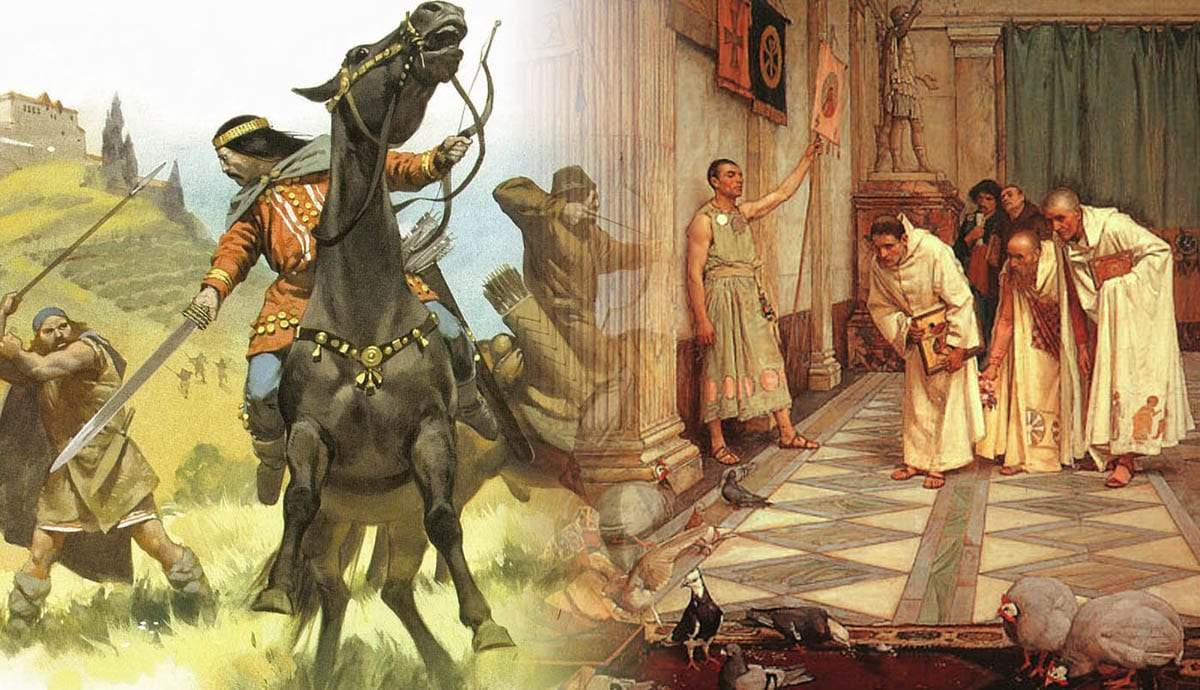

- Mysterious Origins: The Huns were a nomadic warrior people whose precise origins remain a subject of debate among historians. They are believed to have originated in the Eurasian steppe, but their exact homeland is not definitively known.
- Leader: Attila the Hun: One of the most famous Hun leaders was Attila, who rose to power in the mid-5th century. He is often referred to as “Attila the Hun” and was known for his ferocity and his leadership during the Huns’ invasions into the Western Roman Empire.
- Migrations and Invasions: The Huns began their westward migration in the late 4th century, causing a domino effect of migrations and invasions by other barbarian groups, including the Visigoths and Ostrogoths, who sought refuge within the Roman Empire.
- Battle of Adrianople (378 AD): The Huns’ invasions of the Western Roman Empire culminated in the Battle of Adrianople in 378 AD, where the Roman Emperor Valens was defeated and killed. This battle marked a significant turning point in the decline of the Western Roman Empire.
- Attila’s Invasion: Attila’s invasion of the Western Roman Empire in the 5th century was one of the most devastating. His forces, known for their brutality, plundered cities, including Aquileia and Milan. Attila’s campaign in Gaul and Italy put immense pressure on the weakening Roman Empire.
- Rome Spared: Attila’s invasion of Italy in 452 AD reached as far as the gates of Rome. Legend has it that he was deterred from sacking the city by Pope Leo I and a delegation of Roman senators.
- Death of Attila: Attila died under mysterious circumstances in 453 AD, and his empire soon fragmented. His death marked the decline of the Huns as a major political and military power in Europe.
- Impact on the Roman Empire: The Huns’ invasions, along with those of other barbarian groups, significantly contributed to the fall of the Western Roman Empire. The Roman Empire never fully recovered from these incursions and eventually dissolved in 476 AD.
The Huns, often associated with a sense of fear and mystery, were instrumental in the transformation and decline of the Western Roman Empire. Their invasions, along with the movements of other barbarian groups, helped to reshape the political and social landscape of Europe, ultimately paving the way for the medieval period.
“The Chinese Invention of the Compass (c. 4th Century): Navigating the Path of Innovation”


- Early Magnetic Compass: The invention of the compass in China dates back to the 4th century, during the Han Dynasty. This early compass was known as the “south-pointing spoon” and consisted of a magnetic lodestone spoon placed on a square bronze plate.
- Initial Purpose: The compass’s primary purpose was geomancy or divination, rather than navigation. It was used to align buildings and graves with the cardinal directions, based on the Earth’s magnetic field.
- Principle of Magnetism: The compass relied on the natural magnetic properties of lodestone, a magnetic iron ore. Chinese scholars and inventors were the first to understand and harness the principles of magnetism for practical applications.
- Gradual Transformation: Over time, the compass evolved from its early divinatory use into a navigational tool. By the 11th century, the Chinese had developed a more recognizable compass with a magnetic needle floating in a water-filled bowl, which greatly aided maritime navigation.
- Impact on Exploration: The compass was instrumental in advancing Chinese exploration, including voyages in the South China Sea and the Indian Ocean during the Song Dynasty (960-1279 AD). These maritime journeys expanded China’s trade and cultural influence.
- Diffusion to the West: The compass made its way to the Islamic world and Europe through trade and cultural exchange. By the late Middle Ages, the magnetic compass had become a vital tool for navigation in the Western world.
- Evolving Design: In Europe, the compass underwent further innovations, including the addition of a compass rose and improved designs for use at sea. It played a crucial role in the Age of Exploration and the discovery of the New World.
- Modern Navigation: Today, the compass remains an essential tool for land and sea navigation. It is used in various forms, including magnetic compasses and digital compasses in modern technology.
The invention of the compass in ancient China was a remarkable feat of innovation and engineering. While initially employed for geomantic purposes, it gradually transformed into a crucial navigational tool, facilitating exploration, trade, and cultural exchange across the world. The compass’s enduring legacy can be seen in its continued use in modern navigation and technology.






